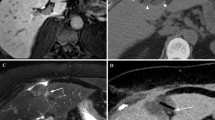Abstract
Purpose
To retrospectively compare efficacy and safety of computed tomography (CT)-guided percutaneous ablation of metastatic lymph nodes (LN) between cryoablation (CA) and radiofrequency ablation (RFA).
Materials and Methods
A bi-central institutional database research identified 28 patients (42 metastatic LNs) who underwent percutaneous CT-guided ablation. RFA group included 18 patients/26 tumors; CA group included 10 patients/16 tumors. Contrast-enhanced CT or MRI was used for post-ablation follow-up. Patient and tumor characteristics, technical and clinical success on a per tumor and a per patient basis and complication rates were recorded, evaluated and compared between the 2 groups.
Results
Both RFA and CA groups had the same median tumor size (2.00 vs. 2.20 cm, p = 0.257), the same median follow-up time (20.50 vs. 20.00 months, p = 0.923) and the same median length of hospital stay (1.00 vs. 1.00 days, p = 0.283). CA group had a higher median procedure time (110.50 vs. 52.00 min, p = 0.001). On a per lesion basis, the overall complete response post-ablation was 88.46% (23/26 lesions) in the RFA and 93.75% (15/16 lesions) in the CA group; no association was revealed between local tumor control and ablation technique (p = 0.709). No complications were recorded in both Groups. On a per patient basis, CA had a longer disease-free interval (24.00 vs. 14.50, p = 0.012) which, however, did not affect the overall survival between the two techniques (26.0 vs. 22.0, p = 0.099 for CA and RFA respectively).
Conclusion
Our limited data suggest that CT-guided RFA and CA are equally effective on terms of efficacy and safety for the treatment of metastatic lymph nodes.




Similar content being viewed by others
References
Obinu A, Gavini E, Rassu G, Maestri M, Bonferoni MC, Giunchedi P. Lymph node metastases: importance of detection and treatment strategies. Expert Opin Drug Deliv. 2018;15(5):459–67.
Huang F, Wu G, Yang K. Oligometastasis and oligo-recurrence: more than a mirage. Radiat Oncol. 2014;9:1–9.
Filippiadis D, Charalampopoulos G, Tsochatzis A, Reppas L, Mazioti A, Kelekis A, Kelekis N. Feasibility and safety of percutaneous computed tomography guided radiofrequency ablation of lymph nodes in oligometastatic patients: a single center’s experience. Br J Radiol. 2021;94(1121):20200445.
Pan T, Xie QK, Lv N, Li XS, Mu LW, Wu PH, et al. Percutaneous CT-guided radiofrequency ablation for lymph node oligometastases from hepatocellular carcinoma: a propensity score-matching analysis. Radiology. 2017;282(1):259–70.
Tsoumakidou G, Mandralis K, Hocquelet A, Duran R, Denys A. Salvage lymph-node percutaneous cryoablation: safety profile and oncologic outcomes. Cardiovasc Intervent Radiol. 2020;43(2):264–72.
Qiu Y, Xing Z, He Y, Liu J, Yang Q, Luo Y. Ultrasound-guided thermal ablation for cervical lymph node metastasis from thyroid carcinoma: a meta-analysis of clinical efficacy and safety. Lasers Med Sci. 2021;37(3):1747–54. https://doi.org/10.1007/s10103-021-03428-5.
Autrusseau PA, Cazzato RL, Koch G, Ramamurthy N, Auloge P, De Marini P, Lipsker D, Gangi A, Garnon J. Freezing nodal disease: local control following percutaneous image-guided cryoablation of locoregional and distant lymph node oligometastases: a 10-year, single-center experience. J Vasc Interv Radiol. 2021;32(10):1435–44.
Frich PS, Sigstad E, Berstad AE, Fagerlid KH, Paulsen TH, Bjøro T, Flinder LI. Long-term efficacy of ethanol ablation as treatment of metastatic lymph nodes from papillary thyroid carcinoma. J Clin Endocrinol Metab. 2022;107(5):e2141–7.
Cornelis FH, Monard E, Moulin MA, Vignaud E, Laveissiere F, Ben Ammar M, et al. Sedation and analgesia in interventional radiology: Where do we stand, where are we heading and why does it matter? Diagn Interv Imaging. 2019;100:753–62.
Cazzato RL, Garnon J, Ramamurthy N, et al. Percutaneous image-guided cryoablation: current applications and results in the oncologic field. Med Oncol. 2016;33:1–16.
Llovet JM, Lencioni R. mRECIST for HCC: performance and novel refinements. J Hepatol. 2020;72(2):288–306.
Filippiadis DK, Binkert C, Pellerin O, Hoffmann RT, Krajina A, Pereira PL. CIRSE quality assurance document and standards for classification of complications: the CIRSE classification system. Cardiovasc Intervent Radiol. 2017;40(8):1141–6.
Puijk RS, Ahmed M, Adam A, et al. Consensus guidelines for the definition of time-to-event end points in image-guided tumor ablation: results of the SIO and DATECAN initiative. Radiology. 2021;301(3):533–40.
Hellman S, Weichselbaum RR. Oligometastases. J Clin Oncol. 1995;13(1):8–10.
Mu L, Sun L, Pan T, Lyu N, Li S, Li X, et al. Percutaneous CT-guided radiofrequency ablation for patients with extrahepatic oligometastases of hepatocellular carcinoma: long-term results. Int J Hyperth. 2018;34(1):59–67.
Yuan Z, Xing A, Zheng J, Li W. Safety and technical feasibility of percutaneous ablation for lymph node metastases of hepatocellular carcinoma. Int J Hyperth. 2019;36(1):160–8.
Kodama T, Matsuki D, Tada A, Takeda K, Mori S. New concept for the prevention and treatment of metastatic lymph nodes using chemotherapy administered via the lymphatic network. Sci Rep. 2016;6:32506.
Karnes RJ, Murphy CR, Bergstralh EJ, et al. Salvage lymph node dissection for prostate cancer nodal recurrence detected by 11Ccholine positron emission tomography/computerized tomography. J Urol. 2015;193(1):111–6.
Funding
This study was not supported by any funding.
Author information
Authors and Affiliations
Corresponding author
Ethics declarations
Conflict of interest
The authors declare that they have no conflict of interest.
Ethical Approval
All procedures performed in studies involving human participants were in accordance with the ethical standards of the institutional and/or national research committee and with the 1964 Helsinki Declaration and its later amendments or comparable ethical standards.
Informed Consent
Informed consent was obtained from all individual participants included in the study.
Consent for Publication
Consent for publication was obtained for every individual person’s data included in the study.
Additional information
Publisher's Note
Springer Nature remains neutral with regard to jurisdictional claims in published maps and institutional affiliations.
Rights and permissions
About this article
Cite this article
Filippiadis, D.K., Pua, U., Georgiadi, E. et al. Percutaneous Ablation of Metastatic Lymph Nodes: An Insight from the Comparison of Efficacy and Safety Between Cryoablation and Radiofrequency Ablation. Cardiovasc Intervent Radiol 45, 1134–1140 (2022). https://doi.org/10.1007/s00270-022-03191-2
Received:
Accepted:
Published:
Issue Date:
DOI: https://doi.org/10.1007/s00270-022-03191-2




